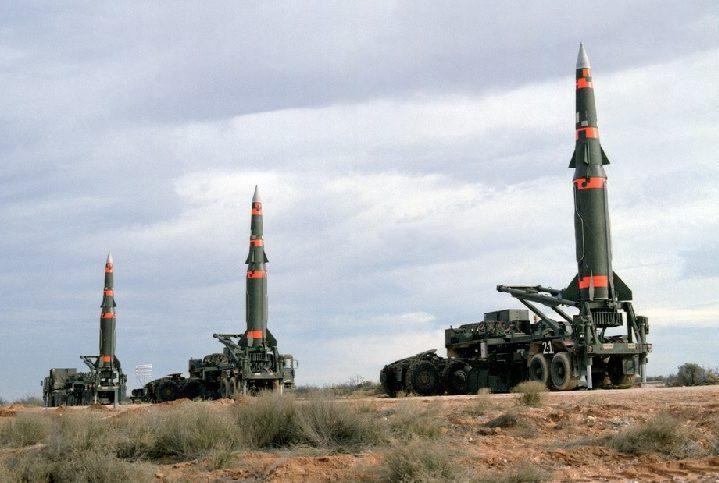Putin’s war could trigger a nuclear-arms race in Asia
Posted By Minxin Pei on March 29, 2022 @ 11:00

Russian President Vladimir Putin’s endgame in Ukraine remains unclear. But his war there does seem to be sending one clear message: if you have nukes, nobody messes with you. The security risks this poses cannot be overestimated.
Just days after launching his invasion of Ukraine, Putin announced that he had placed [1] Russia’s nuclear forces on ‘high alert’—a clear warning to the West not to intervene militarily on Ukraine’s behalf. And it seems to have worked. Despite Russia’s relentless bombardment, including of civilian areas, the United States has flatly refused [2] Ukrainian President Volodymyr Zelensky’s repeated requests for a NATO-enforced no-fly zone.
The reason is simple: The West fears the consequences of all-out war with a nuclear-armed power. While this is not unreasonable, it is likely to erode trust in America’s nuclear umbrella, the effectiveness of which, as a 2020 study [3] showed, was declining long before Russia began its war against Ukraine. The only way a country can credibly protect itself from attack by a nuclear power, it now seems clear, is to maintain nuclear weapons of its own.
For Ukraine, this is particularly frustrating. In 1994, after the end of the Cold War, the country surrendered [4] its nuclear arsenal—then the world’s third largest—in exchange for security assurances that turned out to be meaningless. Not surprisingly, some officials have indicated [5] that they regret disarmament.
Likewise, the Ukraine war has vindicated those countries that were already pursuing nuclear weapons, and they have redoubled their commitment to doing so. In recent weeks, North Korean dictator Kim Jong-un has conducted [6] several high-profile missile tests, including a failed test [7] of a new intercontinental ballistic missile.
But the nuclear power to watch in Asia is China. Since it tested [8] its first nuclear device in 1964, China has adhered to a doctrine of minimum deterrence [9]—essentially, maintaining just enough nuclear weapons to be able to retaliate against a nuclear attack. That is about 350 warheads [10] today, compared [11] to America’s 5,550 and Russia’s 6,000.
So, while China has long possessed a nuclear deterrent, it has avoided wasting hundreds of billions of dollars building a large arsenal—an effort that probably would have triggered a regional nuclear-arms race. There are of course limits to this approach. In a conflict with another nuclear power, China could be neutralised with a pre-emptive strike and missile defence. But a war between nuclear-armed powers seemed so unlikely that maintaining minimum deterrence seemed like a good bet.
The deepening cold war with the US changed China’s strategic calculations. Last December, the US Department of Defense estimated that China was seeking [10] to double its nuclear stockpile by 2027 and amass 1,000 warheads by 2030.
Following the Ukraine war, China will surely strengthen these efforts. It certainly has the resources for a massive arms buildup. And, with Putin issuing nuclear threats and tensions over Taiwan intensifying, the strategic imperative is stronger than ever.
But the nuclear buildup will not stop with China. Several of Asia’s key players are now set to be dragged into a costly and dangerous arms race that will make the entire region less secure. India, China’s regional rival, will seek to expand its own arsenal, prompting India’s nuclear-armed nemesis, Pakistan, to do the same.
This would place East Asia’s non-nuclear states, such as Japan and South Korea, in a quandary. Already, former Japanese prime minister Shinzo Abe has called [12] for Japan to consider hosting American nuclear weapons. Though the current prime minister, Fumio Kishida, quickly rejected [13] the idea, the proposal represents a major shift in a country that has abided by the principles of nuclear non-proliferation since World War II.
If an Asian nuclear-arms race takes hold, countries’ willingness to challenge taboos will only increase. In both Japan and South Korea, nuclear weapons will become the most divisive domestic political issue, with national-security hawks advocating their development, even if doing so jeopardises relations with the US, which views nuclear proliferation as an existential threat.
Finally, Taiwan might decide to acquire nuclear weapons as insurance against a Chinese invasion. But this would almost certainly precipitate just such an invasion. The resulting conflict, which could well involve the US, could quickly escalate into a nuclear war.
The world has long depended on the principle of mutual assured destruction to prevent nuclear war. But, even if MAD deters countries from launching premeditated wars, it cannot protect against accidents or miscalculations. The more nuclear weapons the world has, and the more fearful countries are that their adversaries will launch pre-emptive strikes, the more acute the risks become.
By bolstering the case for more nuclear weapons in Asia, Putin’s war in Ukraine could decimate what little is left of the region’s strategic stability. This not only poses an existential threat to Asia; it would also deliver yet another blow to the global non-proliferation regime, making it even harder to prevent the spread of nuclear weapons in other regions.
Article printed from The Strategist: https://aspistrategist.ru
URL to article: /putins-war-could-trigger-a-nuclear-arms-race-in-asia/
URLs in this post:
[1] placed: https://apnews.com/article/russia-ukraine-kyiv-business-europe-moscow-2e4e1cf784f22b6afbe5a2f936725550
[2] flatly refused: https://foreignpolicy.com/2022/03/16/poll-no-fly-zone-ukraine-zelensky-speech-biden/
[3] 2020 study: https://s3.us-east-1.amazonaws.com/files.cnas.org/documents/CNAS-Report-Proliferation-Trends-Final-C-web.pdf?mtime=20200902104509&focal=none
[4] surrendered: https://www.armscontrol.org/factsheets/Ukraine-Nuclear-Weapons
[5] indicated: https://www.nytimes.com/2022/02/20/world/europe/some-in-ukraine-a-former-nuclear-power-now-regret-disarmament.html
[6] conducted: https://www.france24.com/en/asia-pacific/20220310-north-korea-testing-new-intercontinental-ballistic-missile-system-us-says-vowing-new-sanctions
[7] failed test: https://www.npr.org/2022/03/16/1086876229/north-korean-missile-test-ends-in-failure-its-part-of-a-larger-push-for-a-new-ic#:~:text=SEOUL%20%E2%80%94%20An%20attempted%20North%20Korean,has%20not%20conducted%20since%202017.
[8] tested: https://www.ctbto.org/specials/testing-times/16-october-1964-first-chinese-nuclear-test#:~:text=On%2016%20October%201964%2C%20the,1950s%2C%20after%20the%20Korean%20war.
[9] minimum deterrence: https://carnegieendowment.org/2016/06/30/china-s-nuclear-doctrine-debates-and-evolution-pub-63967
[10] 350 warheads: https://www.armscontrol.org/act/2021-12/news/pentagon-sees-faster-chinese-nuclear-expansion
[11] compared: https://www.vox.com/22951004/nuclear-weapons-russia-ukraine-war-putin
[12] called: https://www.theguardian.com/world/2022/mar/01/china-rattled-by-calls-for-japan-to-host-us-nuclear-weapons
[13] rejected: https://www.upi.com/Top_News/World-News/2022/02/28/japan-Fumio-Kishida-nuclear-sharing-United-States-NATO/1861646043936/
Click here to print.